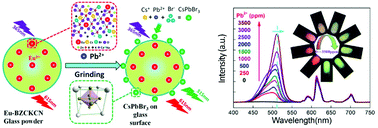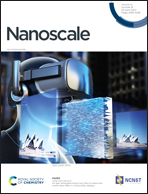A solid-state colorimetric fluorescence Pb2+-sensing scheme: mechanically-driven CsPbBr3 nanocrystallization in glass
Abstract
Highly toxic Pb2+ poses a great threat to the health of human beings and ecosystems, urgently calling for an efficient Pb2+ detection method. Herein, we demonstrated a brand-new solid-state fluorescence Pb2+-sensing scheme based on a type of Pb2+-responsive borate glass powder that is able to precipitate CsPbBr3 nanocrystals on the glass surface upon grinding with Pb2+ sources, following a mechanically driven glass crystallization mechanism. Pb2+ sensing is achieved via the Pb2+ concentration-dependent green emission of CsPbBr3 as an indicator signal and independent red emission of Eu3+ as a reference signal. Under UV light irradiation, the obvious emissive color variation from red to green as Pb2+ concentration varies enables the intuitive Pb2+-sensing by naked eyes. With the aid of a spectrometer and smartphone, Pb2+ concentration can be quantitatively determined with the detection limit as low as ∼70 ppm and ∼400 ppm, respectively. The semi-quantitative Pb2+ detection is also possible by comparing the emissive color with the calibrated color card. Hopefully, the proposed solid-state fluorescence Pb2+-sensing strategy with high selectivity can be used for portable and quick Pb2+ analysis in daily life.

- This article is part of the themed collection: Celebrating 60 years of the Fujian Institute of Research on the Structure of Matter


 Please wait while we load your content...
Please wait while we load your content...